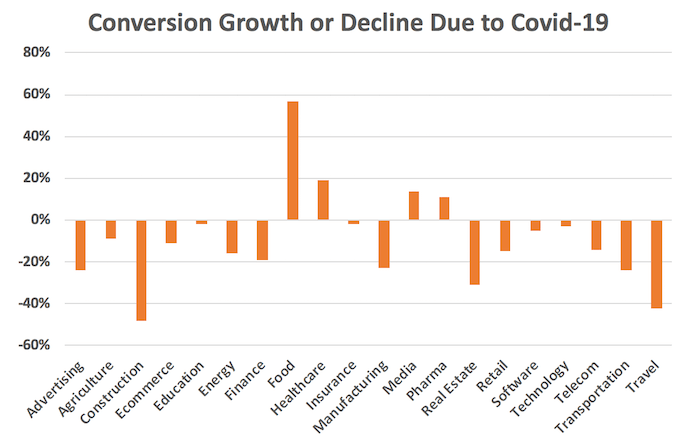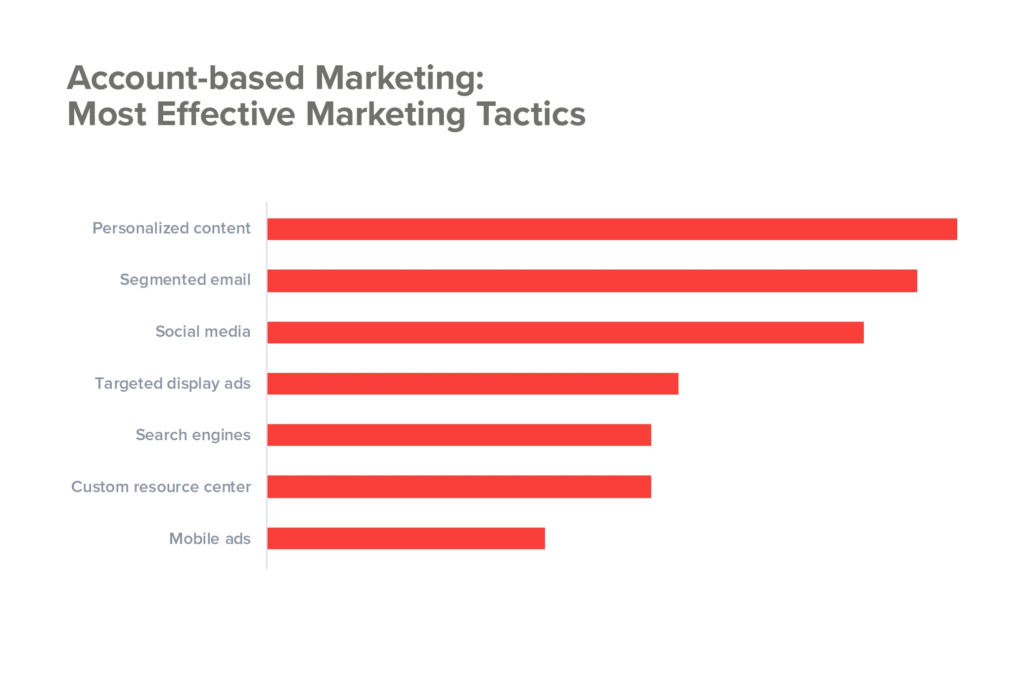
Introduction
In the last few months, COVID-19 has affected the business world in a way no company ever anticipated. The pandemic has put conventional methods of selling and marketing to test and created a new business environment. This requires salespeople and marketers to rethink their strategies in these very uncertain times.
Irrespective of this reality, B2B marketers and sales reps can still find innovative strategies for positioning their products and services in the market amid and even after the COVID-19 pandemic. One such strategy to use account-based marketing (ABM) to adapt to the current crisis. ABM is about identifying specific companies that you want to do business with and developing customized marketing campaigns for each of them.
The success of ABM as a marketing approach is not in question. Research conducted by ITSMA shows that 87% of marketers report that return on investment from ABM supersedes that of any other approach.
Below we explore 7 steps that B2B salespeople and marketers can take to develop an emergency ABM action plan. But before we delve into this, let’s see why B2B companies should consider ABM during COVID-19.
Why Consider Account-Based Marketing During COVID-19?
The COVID-19 crisis has affected lead generation strategies that many companies use negatively. Events and in-person meetings are no longer viable ways of generating leads in the current environment. But these are not the only strategies that have been affected by the pandemic. The effectiveness of inbound lead generation strategy has also dropped significantly due reduced conversion rates and web traffic.

Source: NeilPatel
But as the effectiveness of other lead generation strategies reduces, ABM promises to deliver better the results for companies during this crisis period for the following reasons:
- ABM is driven by empathy: B2B marketing is about targeting decision makers. Applying ABM means salespersons and marketers seek to understand how these targets are being affected by the pandemic before they can craft their messages or initiate contact.
- ABM aligns sales with marketing: A misaligned sales and marketing function kills productivity, even when businesses are operating in an ordinary environment. During the pandemic, it is critical that the two teams are properly aligned and focused towards achieving the same goal – ABM facilitates this.
- ABM delivers quality content: B2B companies that embrace ABM are able to deliver high quality content that is personalized and empathetic to the needs of their target audience.
7 Steps for Developing an Emergency ABM Action Plan for Sales Reps and Marketers
During the pandemic, preparing an ABM emergency action plan can help B2B companies adapt to the current environment and navigate the uncharted waters they find themselves in. Here are seven steps that could help with this process:
Step 1: Review your ABM Goals
The first step in developing an emergency ABM action plan is to review your current goals to make them as realistic as possible in light of the current environment. This means company executives, marketing and sales teams need to come together to review current operations and determine how they’ll need to change to adapt to the current environment.
In this step, B2B company teams invest time rethinking key company benchmarks. They also predict market disruptions and changes that are likely to occur in the new operating environment. Most importantly, they determine whether additional resources, new skills and strategies will be required to enable the company to navigate the crisis.
This is critical because without undertaking a review, it will be difficult for your company to maneuver the crisis. Though the details of the new goals vary from one industry to another, going through this process enables sales and marketing teams to lay a good foundation for the next steps.
Step 2: Create Market Scenarios
The changes that COVID-19 continues to bring are unprecedented. Nobody knows how fast these changes will happen or at what frequency they will happen. To prepare adequately, B2B companies need to create different scenarios showing the best as well as the worst possible cases. This is not an exercise that just a few people can do.
You’ll need to bring your entire sales and marketing teams together for a scenario building session to get a clear picture of the situation now and in the near as well as distant future. Besides the sales and marketing teams, B2B companies should consider bringing in staff from other departments.
The more people you have engaging in this step, the easier it will be to think about the changes that COVID-19 is bringing to the company, the industry and target audience. It will also make it easy for you to gather insights on how the pandemic is affecting your company and generate ideas on how to achieve its sales and revenue goals in the new environment.
Step 3: Identify High Value Accounts
According to DemandBase, 83% of B2B companies that use ABM report increased engagement with target prospects is one of the key benefits of ABM. The reality is that each company has unique needs, issues and goals. To appeal to them individually, you need to target them with content that addresses their needs.
In this step, B2B sales and marketing teams engage in research to identify clients that they need to target. This research enables them to get an in depth understanding of their intended target including:
- The goals they pursue
- The issues they deal with everyday
- How the products or services can help them solve those issues
- The decision makers in the target company including head of the target department
- The gatekeepers, their personality and the message they’d want to hear
With this understanding, B2B sales and marketing teams can proceed to craft engaging messages that speak to the needs of the target audience and disseminate them. Remember personalized content is the most effective way of succeeding with ABM.
 Step 4: Revise ABM Indicators and Dashboards
Step 4: Revise ABM Indicators and Dashboards
Most B2B companies may have noted that the cost of advertising has gone up significantly in the past few months. This spike has been triggered by demand driven by the fact that during lockdown, most buyers have shifted to online shopping. Businesses are also relying on digital marketing to attract customers.
The shift to digital marketing means that performance indicators and metrics that B2B companies were used with conventional marketing strategies will not work. A revision of these indicators and a change of sales and marketing tracking dashboards will be needed to facilitate performance monitoring.
When updating your performance indicators and metrics, pay more attention to front-looking metrics such as:
- Fluctuations in conversion rates
- Product or company searches and site traffic
- Year-on-year revenue trends
It is advisable that you review your key metrics, dashboards and performance indicators on a weekly basis. This way, you’ll be able to keep tabs on last-minute changes so you can adapt to the and act immediately. The most important thing to do at this point is to recognize the new reality and adapt to it.
Step 5: Adjust Sales and Marketing Team Roles
COVID-19 has changed the way sales and marketing teams go about their activities. Before the pandemic, sales teams were focused more on outbound sales. Things have changed and now these teams are largely involved in inside sales. In the same way, marketing teams have to rethink their marketing calendars and move their advertising activities online.
These strategy changes means a shift in the roles that each team played before COVID-19. Clarifying the new roles that each team needs to take up is critical to implementing your ABM action plan. This means evaluating how each team’s skills and strengths will evolve in the current environment to deliver the desired results.
For instance, a key skill that both teams will need is hosting remote meetings and events. If your marketing team has no experience in hosting online events, this is a skill it has to run to succeed in the current environment. The same applies to sales teams – they’ll need to run how to make online presentations and demos in order to generate and nurture leads in this new environment.
In addition to technical skills, B2B companies need to build the capacity of their sales and marketing teams on soft skills – especially empathy – that are critical in navigating the current environment.
Step 6: Review ABM Activity Budgets
When you are navigating a crisis, you need to keep an eye on your cash flow and balance available resources. You need to determine how much you need to spend adapting to the new situation and how much you need to save.
Taking time to review your sales and marketing budget enables you to optimize performance and preserve your profits. The best way to review your budgets is to list:
- Essential activities that must be implemented to move the company forward
- Activities that are not essential but are nice to implement
- Luxurious activities that are not necessary
Once you have these activities listed, have your sales and marketing teams review them. This will enable you to build consensus on which activities to implement and the resources you need.
Step 7: Prepare Social Proof to Convince Decision Makers
A 2019 survey shows that 80% of B2B buyers in the US are concerned about a possible recession. With the current pandemic, a recession appears to be more real than ever. As such, your prospects could be reducing spending to preserve their budgets for the most essential expenses and minimize financial damages.
To convince your target B2B decision makers, social proofs such as whitepapers, case studies and reviews can go a long way in boosting your ABM initiative during COVID-19. They also make it easier for sales teams to demonstrate the benefits of your products or services to your target audience during these desperate times.
Bottom Line
B2B companies across the world find themselves in uncharted waters due to the COVID-19 pandemic. In this difficult situation where companies struggle to stay afloat, developing an emergency ABM action plan can go a long way in helping your company to act fast and even adapt to the current environment. Following the seven steps discussed above can help you to get there faster.
Our blog
Latest blog posts
Tool and strategies modern teams need to help their companies grow.

This comprehensive guide covers everything about service marketing—its unique chara...

Believe it or not, the concept of content sharing existed long before the Internet. I...

Sales analysis is essential to avoid inaccurate forecasts and identify improvement op...
 Step 4: Revise ABM Indicators and Dashboards
Step 4: Revise ABM Indicators and Dashboards



